Evaluate the Following Limit Using l-Hopital-s Rule
Subscribe to our ▶️ YouTube channel 🔴 for the latest videos, updates, and tips.
Evaluate the following limits, if necessary use l'hopital rule :
Problem 1 :

Solution :
= lim x-->0 (1 - cos x)/x2
By applying the given function,
= (1 - cos 0)/02
= (1 - 1)/0
= 0/0
Indeterminant form.
Differentiate the numerator and denominator, we get
= lim x-->0 [0 -(-sin x) / 2x]
= lim x-->0 (sin x / 2x)
Applying the limit, we get 0/0.
= lim x-->0 (cos x / 2(1))
= lim x-->0 cos x/2
Applying the limit, we get
= cos (0) /2
= 1/2
lim x-->0 (1 - cos x)/x2 = 1/2
Problem 2 :

Solution :
Factoring x2, we get
= lim x-> ∞ x2(2 - 3/x2) / x2(1 - 5/x + 3/x2)
= lim x-> ∞ (2 - 3/x2) / (1 - 5/x + 3/x2)
By applying the limit, we get
= 2/1
= 2
So, the answer is 2.
Problem 3 :

Solution :
By applying the limit, we get
= ∞/log ∞
= ∞/0
= ∞
So, the answer is ∞.
Problem 4 :

Solution :
= lim x--> π/2- sec x / tan x
Applying the limit, we get
= sec (π/2) / tan (π/2)
= ∞/∞
Indeterminant form.
Using L'Hopital's rule, differentiate the numerator and denominator. we get
= lim x--> π/2- sec x tan x / sec2 x
= lim x--> π/2- tan x / sec x
= lim x--> π/2- (sin x / cos x) / (1/cos x)
= lim x--> π/2- (sin x / cos x) x (cos x / 1)
= lim x--> π/2- sin x
Applying the limit, we get
= sin (π/2)
= 1
So, the value of lim x--> π/2- sec x / tan x is 1.
Problem 5 :

Solution :
= lim x--> ∞ e-x √x
The given function is not in the form of f(x) / g(x)
= lim x--> ∞ (√x / ex)
Applying the limit, we get
= (√∞ / e∞)
= ∞/∞
Indeterminant form.
Differentiate the numerator and denominator separately, we get
= lim x--> ∞ (1/2√x / ex)
= lim x--> ∞ (1/2√∞ / e∞)
= 1/2(∞) / ∞
= 0/∞
= 0
So, the answer is 0.
Problem 6 :

Solution :
= lim x--> 0 (1/sin x - 1/x)
The given function is not in the form of f(x)/g(x).
= lim x--> 0 (x - sin x)/x sin x
Applying the limit, we get
= (0 - sin 0)/0 sin 0
= 0/0
Indeterminant form.
Differentiate the numerator and denominator, we get
= lim x--> 0 [(1 - cos x)] / [x cos x + sin x(1)]
= lim x--> 0 [(1 - cos x)] / [x cos x + sin x]
Applying the limit, we get
= 0/0
Differentiating the numerator :
= (0 - (-sin x))]
= sin x
Differentiating the denominator :
= x (-sin x) + cos x (1) + cos x
= -x sin x + cos x + cos x
= -x sin x + 2 cos x
= lim x--> 0 sin x/ (-x sin x + 2 cos x)
Applying the limit, we get
= sin 0/2 cos 0
= 0/2(1)
= 0
So, the value of lim x--> 0 (1/sin x - 1/x) is 0.
Problem 7 :

Solution :
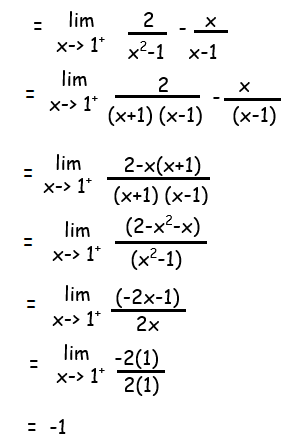
So, the answer is -1.
Problem 8 :

Solution :
Let f(x) = xx
y = xx
log y = log xx
log y = x log x
log y = log x / (1/x)
lim x->0+ log y = lim x->0+ log x / (1/x)
lim x->0+ log y = ∞/∞ (Indeterminant form)
Using L'Hopital's rule :
lim x->0+ log y = lim x->0+ (1/x) / (-1/x2)
lim x->0+ log y = lim x->0+ -x
By applying limit, we get
lim x->0+ log y = 0
log (lim x->0+y) = 0
(lim x->0+y) = e0
lim x->0+ y = 1
So, the answer is 1.
Problem 9 :

Solution :
Let f(x) = (1 + (1/x))x
y = (1 + (1/x))x
log y = log (1 + (1/x))x
log y = x log (1 + (1/x))
log y = log (1 + (1/x)) / (1/x)
lim x ->∞ log y = lim x ->∞ log (1 + (1/x)) / (1/x)
By applying the limit, we get
lim x ->∞ log y = lim x ->∞ log (1 + (1/∞)) / (1/∞)
lim x ->∞ log y = lim x ->∞ log (1)/0
lim x ->∞ log y = 0/0 (Indeterminant form)
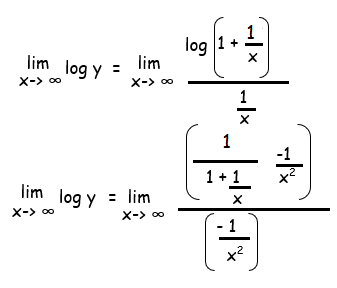
By applying the limit, we get
lim x ->∞ log y = 1
log (lim x ->∞ y) = 1
lim x ->∞ y = e
Problem 10 :

Solution :
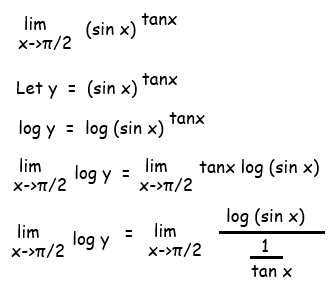
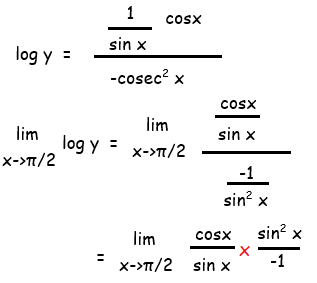
lim x->π/2 log y = lim x->π/2 (- sinx cosx)
By applying the limit, we get
lim x->π/2 log y = -sin(π/2) cos(π/2)
lim x->π/2 log y = 1(0)
lim x->π/2 log y = 0
log y (lim x->π/2 y) = 0
(lim x->π/2 y) = 1
So, the answer is 1.
Problem 11 :

Solution :
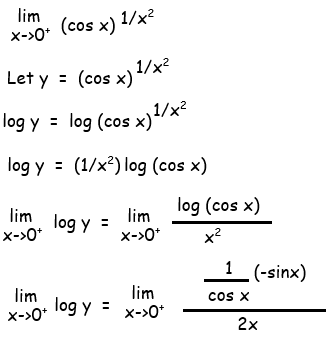
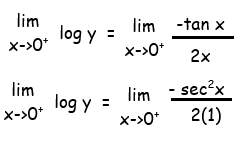
By applying the limit, we get
lim x->0+ log y = -1/2
log(lim x->0+ y) = -1/2
lim x->0+ y = e-1/2
lim x->0+ y = 1/√e
So, the answer is 1/√e.
Problem 12 :
If an initial amount A0 of money is invested at an interest rate r compounded n times a year, the value of the investment after t years is

If the interest is compounded continuously, (that is as n->∞), show that the amount after t years is A = A0 ert
Solution :
A = A0 (1+ r/n)nt
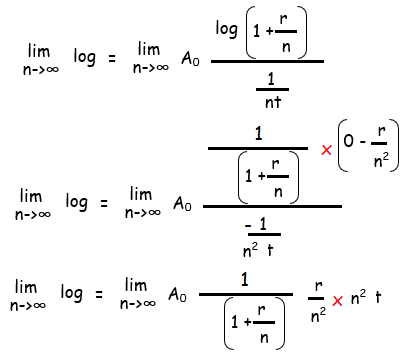
By applying the limit, we get
log (lim n->∞ y) = rt
lim n->∞ y = ert
A = A0 ert
Subscribe to our ▶️ YouTube channel 🔴 for the latest videos, updates, and tips.
Kindly mail your feedback to v4formath@gmail.com
We always appreciate your feedback.
About Us | Contact Us | Privacy Policy
©All rights reserved. onlinemath4all.com

Recent Articles
-
Times Table Shortcuts
Dec 30, 25 07:14 PM
Times Table Shortcuts - Concept - Examples -
10 Hard SAT Math Questions (Part - 42)
Dec 30, 25 05:52 AM
10 Hard SAT Math Questions (Part - 42) -
10 Hard SAT Math Questions (Part - 38)
Dec 29, 25 04:21 AM
10 Hard SAT Math Questions (Part - 38)

